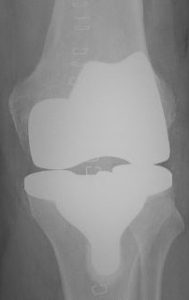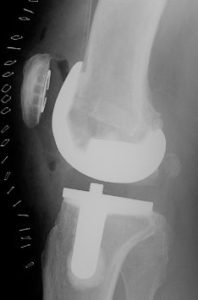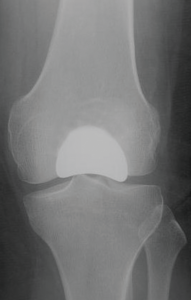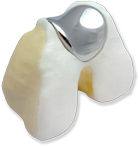
Patient Information
Do you have severe pain under or around your kneecap?
Have you been told by your doctor that you may need knee replacement surgery?
Are you interested in learning about a less-invasive partial knee replacement that is custom made just for you?
What are your options?
If you have severe pain under and around your kneecap, your doctor may first recommend conservative treatment involving rest, physical therapy and analgesics. If your pain is not manageable with these measures, you may be a candidate for surgery.
Types of surgery for arthritis around the kneecap
There are several types of surgery intended to treat severe arthritis around the kneecap. These options include soft tissue procedures (such as a lateral release), cartilage replacement, chondroplasty, microfracture, bone and tendon realignment procedures, and replacement of the painful portion of the knee (partial and total knee replacement).
Replacement of the entire knee joint (total knee replacement) has been used to treat arthritis that is isolated to the kneecap portion of the knee. With total knee replacement, however, all portions of the knee are replaced, even if they are healthy!
Many experts believe that total knee replacement is too aggressive for someone who suffers from arthritis in just one portion of the knee. These experts believe that your knee will function better if you are able to keep the healthy portions in your knee and only replace the area that is damaged. Another consideration is that total knee replacement requires removal of bone from your entire knee and, if the implant does not last you for the rest of your life, the challenges of subsequent repair are increased because there is simply less bone to work with for implantation of the revision knee components.
Patello-Femoral Replacement (PFR)
Patello-Femoral Replacement is a more conservative type of partial knee replacement that is designed to replace just the area under your kneecap – the patellofemoral compartment – while sparing the rest of the knee. Your doctor may determine that patellofemoral replacement is right for you if your patellofemoral compartment is significantly arthritic and your other two knee compartments are healthy.
Standard off-the-shelf patellofemoral implants have been available for many years. These off- the-shelf implants have a fixed shape and are available in a limited number of sizes. Results with these implants have not been as consistent as many surgeons would like. After trying off-the- shelf patellofemoral implants, many surgeons reverted to simply using a total knee replacement.
Comparison of total knee replacement to partial knee replacement with a KineMatchⓇ Patient-Matched PFR
The KineMatch Patient-Matched PFR was developed as a better solution for patients suffering from isolated patello-femoral disease.
What is the KineMatch Patient-Matched PFR?
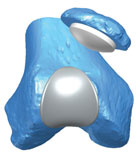
Fig. 1 – A virtual computer model of a patient’s knee showing the design for the patient’s KineMatch custom made implant.
The KineMatch Patient-Matched PFR is a custom made implant, designed and fabricated to fit your knee and only your knee (Figs. 1 & 2). While off-the-shelf implant designs come in several sizes and are “fit” by cutting your bone to match the implant shape, the KineMatch Patient-Matched PFR takes the opposite approach by using a CT scan of your knee to create a virtual computer model of your knee and to fabricate an implant that fits your knee without cutting away your bone. This custom solution provides the opportunity to optimize the biomechanics of your knee.
The KineMatch Patient-Matched PFR is considered a partial knee replacement, designed to address arthritis in just one portion of your knee – in this case the patellofemoral compartment. The “PFR” in the name stands for “Patello-Femoral Replacement.”
Not all patients with arthritis of the knee are candidates for this particular implant – it depends on where the arthritis is located in your knee. If you have been diagnosed with isolated patello-femoral arthritis, you may be a good candidate for the KineMatch Patient-Matched PFR.
Partial knee replacement with the KineMatch Patient-Matched PFR is covered by most insurance plans.
KineMatch 3-D Animation
Let’s talk about the anatomy of the knee
The knee is comprised of three separate compartments or portions where one bone articulates or “slides” against another. One or more of these compartments can be affected by arthritis. The joint between the femur (thigh bone) and the tibia (shin bone) has two articulations – the medial (inner knee) compartment and the lateral (outer knee) compartment. The third articulation in the knee is called the patellofemoral compartment – it is the joint formed by the front of the femur and the patella (kneecap) as it glides up and down the front of the femur while we walk, run, climb stairs or just get up from a chair.
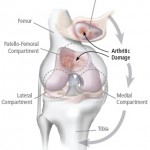
Fig. 3 – Illustration of knee showing the bones, the three ‘compartments’ of the knee and isolated patello-femoral arthritis. (Click to view larger illustration.)
The three compartments of the knee are shown in Figure 3. Arthritis can be isolated to any one of the three compartments or can occur in two or three at the same time. If your arthritis is isolated to the patellofemoral (kneecap) portion of the joint and is severe, you may be a candidate for patello-femoral replacement. Your doctor can examine your knee and determine if your knee arthritis is isolated to the patellofemoral compartment.
Benefits of a Patient-Matched patello-femoral replacement
Reported Clinical Results
Data published in peer-reviewed medical literature demonstrate the effectiveness of the KineMatch Patient-Matched PFR for patients who have been followed for a mean duration of 11 years1, 2. The results achieved with the KineMatch Patient-Matched PFR are significantly better than results with similar off-the-shelf implants.
1 Sisto (2006) Custom Patello-femoral Arthroplasty of the Knee. Journal of Bone & Joint Surgery. Volume 88-A. Pages 1475-80.
2 Sisto (2011) Custom Patello-femoral Arthroplasty of the Knee: An Eleven Year Follow-Up. Presented at the Orthopaedic Research Society annual meeting.
Quicker Recovery Compared to Total Knee Replacement
Surgeons using the KineMatch Patient-Matched PFR note that their patients typically recover more quickly and experience less post-operative discomfort than total knee replacement patients. This can be attributed to the greatly reduced removal of bone, the significantly reduced surgical trauma, and the preservation of the medial, lateral, and cruciate structures of the knee. In addition to reduced pain and post-operative swelling, this leads to less post-operative physical therapy and an earlier return to function and daily activities.
Is the Patient-Matched PFR right for me?
Your orthopedic surgeon will be able to determine the extent and location of your osteo-arthritis to determine if the KineMatch Patient-Matched PFR is appropriate for you. A clinical exam and careful review of your x-rays, MRI scans, and arthroscopy images will determine the extent and location of the arthritic damage to your knee.
What can I expect?
If you and your surgeon decide that you are a candidate for Patient-Matched PFR, then you will be asked to undergo a CT scan of your knee. The CT scan itself takes about fifteen minutes. Your CT scan digital data will then be sent to Kinamed for manufacture of the implant. Your custom made PFR implant will then be ready for your surgery in approximately six weeks.
The surgery typically takes about an hour. In most cases, you will spend one night in the hospital after surgery. Your surgeon will probably want you up on your feet with the aid of crutches later during the day of the surgery and you will go home with the crutches. Most patients typically need the crutches only for a short while and are able to discontinue them more quickly than total knee replacement patients. Your post- operative recovery and physical therapy will be dependent on the extent of your pre-operative disability.
Ask your doctor if patello-femoral replacement is right for you!
Patient Testimonials
“I can tell you with great pleasure that I am completely back to normal. The knee is doing so well that at times I forget that I had the surgery. I can do the stairs without using the railing. As one who has gone through so many painful joint surgeries, the advancements that have been made in this field are truly amazing. You as a doctor must be thrilled with the results.” – Susan S.
“Just a quick up-date to let you know that I continue to recover and increase my activity level. A 4-5 mile walk in the early morning will leave me with some discomfort only. I can do stairs without any support or need for stabilization. I sleep through the night without awakening from the pain. I have taken a new position [at a new hospital]. This was a big move for my wife and me but a great opportunity… Thanks for your great work on my knee. It has been an answer to our prayers.” – Donald D., MD
A KineMatch Patient’s Personal Story
Britt was active her entire life, however, when chronic joint pain started to slow her down and cause her to miss out on special moments with her family, she knew she needed to do something. Dr. Jon Henry, orthopedic surgeon who is fellowship trained in sports medicine at Aurora BayCare, Green Bay, WI, USA, provided Britt with a joint preservation plan that utilized KineMatch Patient-Matched PFR implants to repair damage in both her knees. Today, she is back to doing all the things she loves with her family and their dogs.
“The reason that this custom joint preservation plan that Dr. Henry performed was so successful was because it’s just what I needed. I didn’t need my whole knee replaced. I didn’t have to recover from a whole knee replacement. Once I had the procedures and healed from them, I’m back to doing whatever I want. In my restrictions that Dr. Henry gave me were… ‘no restrictions’.” – Britt S.
Surgeon Testimonials
“I have tried several of the off-the-shelf patello-femoral arthroplasty implants and have concluded that the KineMatch Patient-Matched PFR is consistently the best option for my patients requiring patellofemoral arthroplasty. The concept of using CT data to customize the backside of the implant to intimately fit the trochlea without need for bone resection is conservative, effective, and simplifies and speeds the surgical procedure.”
Russell Cecil, MD, Mohawk Valley Orthopedics, Amsterdam, NY, USA
“I have been performing KineMatch custom-fit patello-femoral arthroplasty for years. I am very pleased with the rapid return of function and range of motion.”
Gregg R. Foos, MD, Double Board Certified, Fellowship Trained Orthopaedic Surgeon, Tinton Falls, NJ, USA
“I began using the KineMatch PFR in 2011 and have performed over 90 cases to date. I have found this device to be an excellent solution for patients with isolated end-stage patello-femoral disease.”
Robert J. Greenhow, MD, FRCSC, Diploma Sports Medicine, Peak Orthopedics and Spine (a division of Orthopedic Centers of Colorado) Englewood, CO, USA
“I started performing KineMatch custom-fit patello-femoral arthroplasty in 2007. I am very pleased with the rapid pain relief, quick return of range of motion and function, as well as the short operative time and learning curve.”
Ronald P. Grelsamer, MD, Chief of Patello-Femoral Reconstruction Mount Sinai Medical Center, New York, NY, USA
“In my experience the KineMatch PFR has been an excellent option for younger (<55 year old) patients with end-stage OA isolated to the PF joint. We have used the KineMatch system with success on more than 60 patients in our practice since 2007. With proper patient selection this has been a reliable and powerful tool to restore quality of life, even in individuals with very active lifestyles.”
Jon Henry, MD, Aurora BayCare Orthopedic & Sports Medicine Center, Green Bay, WI, USA
“This patient specific design and manufacturing technique ensures accurate and precise anatomic fit while simultaneously providing proper patellofemoral alignment and medial lateral constraint.”
Adolph V. Lombardi, Jr., MD, FACS, Joint Implant Surgeons, Inc. New Albany, OH, USA
“The KineMatch device has offered a remarkable benefit and return to function for a number of my patients with intractable patello-femoral disease who were otherwise facing the prospect of TKR.”
Domenick J. Sisto, MD, Sherman Oaks, CA, USA
“I have found the KineMatch patella femoral replacement system offers excellent results in patients with arthritis isolated to the patello-femoral (kneecap) portion of the knee. It works especially well for younger active patients who don’t warrant a total knee replacement.”
Brian M. Torpey, MD, Double Board Certified, Fellowship Trained Orthopaedic Surgeon, Tinton Falls, NJ, USA
Statement of Indications For Use
The United States Food and Drug Administration requires that a specific statement of Indications for Use be included in the medical literature covering this device. Here are the indications for the KineMatch Patient-Matched PFR:
“The KineMatchⓇ Patello-Femoral Resurfacing Implant is intended to be used in patello-femoral arthroplasty in patients with degenerative arthritis of the distal femur and patella, patients with a history of patellar dislocation or patella fracture, or patients with failed previous surgery where pain, deformity, or dysfunction persists.”

